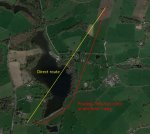- Joined
- Apr 23, 2019
- Messages
- 145
- Reaction score
- 61
- Location
- Cheshire, England
- Website
- www.youtube.com
Until recently I was delighted with the 3-at-a-time battery charger accessory which seems to rapidly charge three batteries at once with no problems. But perhaps, maybe, just perhaps, it almost cost me my drone today.
I had just flown a big juicy Flight Plan which involved a loss of signal and flying low in a distant location. I always try to be conservative with such flights duration so that if things take longer than planned the battery has plenty of spare juice. I think this plan was less than 8 minutes duration. When it was finished I noticed that I had lots of battery left so I flew on manually, on a bit of a high after pulling off what I believed was a great flight. I was having so much fun I miscalculated where the drone had got to and I find myself looking at a distance of (I think) 1435 metres and a battery level of 24%. Ah. This is not good, I thought to myself. A successful return is not exactly guaranteed from this position, especially considering that there is a lake between me and the drone. RTH would have taken the drone over the lake and it might not make it. I decided that it was better to fly manually and take it over empty fields so if it ran out of power it would at least land somewhere that I had a chance of rescuing it from. I pushed it to full speed and aimed it around the edge of the lake, dropping altitude as I went. It always makes sense to drop altitude when flying home as it will use less power in descending, it will reduce the total distance (vertical distance needs to be covered as well as horizontal) and if the worst happens it won't have as far to fall. I am very glad that I did. I saw the drone clear the final trees and it was heading my way, it will be with me in less than ten seconds I thought. Then I was lining it up for the most direct route across the last 200 metres or so it just fell out of the sky from tree-top height. The battery level was 15%, with no warning of any kind it seemed to lose power completely and flutter down to the ground whereupon the battery bounced up. I was close enough to hear the thud. I had to climb over a barbed-wire fence precisely the same height as my scrotum to find it. I was fearing that it would be smashed up. It wasn't, apart from the battery disconnecting and some dust on the props there seems to be no damage at all. As they say the bigger they come the harder they fall, the Anafi is so light it can withstand quite a fall.
The Anafi has flown on since. I gave it a short test hover then I decided that the only way to prove it was to give it a proper workout so I loaded up a seven-minute flight plan and it performed faultlessly. I did do a little extra manual flight at the end of it but for some reason I decided to bring it home with about 25% battery left. There's tempting fate and then there's poking it in the eye with a sharp stick.
So I have had TWO instances of the Anafi dropping out of the sky when the battery level was 14 or 15%. The previous one was a couple of days earlier and it was flying less than waist height and landed in some long grass. It was annoying to lose the video recording but I didn't think too much about what had happened. Of course I thought about it when I was looking at that awkward situation of possibly pushing the Anafi as far as the battery could take me, which is why I avoided the lake. I have flown over the lake dozens of times when returning with low power but never with quite as little margin as that. If I had flown directly over the lake I think it probably would have managed to clear it but my nerves would be in shreds and it might have instead fallen on my head.

The map should show why I took the decision that I did. There would be nearly 500 metres of extremely bad places to crash on the most direct route if you add up the water, trees and gardens of people who I could not count on as friendly. The route I did take was almost entirely fields.
I have decided not to use the 3-at-a-time battery charger again because that might be the explanation for the battery problems I have been developing. I think I need to keep a log of battery performance and which charger I have used with which battery. I also need to look into resetting the batteries. Until I have got to the bottom of this I will be landing the Anafi with at least 17% battery left and I will be ensuring that I don't fly too far from home when the levels are getting low.
I had just flown a big juicy Flight Plan which involved a loss of signal and flying low in a distant location. I always try to be conservative with such flights duration so that if things take longer than planned the battery has plenty of spare juice. I think this plan was less than 8 minutes duration. When it was finished I noticed that I had lots of battery left so I flew on manually, on a bit of a high after pulling off what I believed was a great flight. I was having so much fun I miscalculated where the drone had got to and I find myself looking at a distance of (I think) 1435 metres and a battery level of 24%. Ah. This is not good, I thought to myself. A successful return is not exactly guaranteed from this position, especially considering that there is a lake between me and the drone. RTH would have taken the drone over the lake and it might not make it. I decided that it was better to fly manually and take it over empty fields so if it ran out of power it would at least land somewhere that I had a chance of rescuing it from. I pushed it to full speed and aimed it around the edge of the lake, dropping altitude as I went. It always makes sense to drop altitude when flying home as it will use less power in descending, it will reduce the total distance (vertical distance needs to be covered as well as horizontal) and if the worst happens it won't have as far to fall. I am very glad that I did. I saw the drone clear the final trees and it was heading my way, it will be with me in less than ten seconds I thought. Then I was lining it up for the most direct route across the last 200 metres or so it just fell out of the sky from tree-top height. The battery level was 15%, with no warning of any kind it seemed to lose power completely and flutter down to the ground whereupon the battery bounced up. I was close enough to hear the thud. I had to climb over a barbed-wire fence precisely the same height as my scrotum to find it. I was fearing that it would be smashed up. It wasn't, apart from the battery disconnecting and some dust on the props there seems to be no damage at all. As they say the bigger they come the harder they fall, the Anafi is so light it can withstand quite a fall.
The Anafi has flown on since. I gave it a short test hover then I decided that the only way to prove it was to give it a proper workout so I loaded up a seven-minute flight plan and it performed faultlessly. I did do a little extra manual flight at the end of it but for some reason I decided to bring it home with about 25% battery left. There's tempting fate and then there's poking it in the eye with a sharp stick.
So I have had TWO instances of the Anafi dropping out of the sky when the battery level was 14 or 15%. The previous one was a couple of days earlier and it was flying less than waist height and landed in some long grass. It was annoying to lose the video recording but I didn't think too much about what had happened. Of course I thought about it when I was looking at that awkward situation of possibly pushing the Anafi as far as the battery could take me, which is why I avoided the lake. I have flown over the lake dozens of times when returning with low power but never with quite as little margin as that. If I had flown directly over the lake I think it probably would have managed to clear it but my nerves would be in shreds and it might have instead fallen on my head.

The map should show why I took the decision that I did. There would be nearly 500 metres of extremely bad places to crash on the most direct route if you add up the water, trees and gardens of people who I could not count on as friendly. The route I did take was almost entirely fields.
I have decided not to use the 3-at-a-time battery charger again because that might be the explanation for the battery problems I have been developing. I think I need to keep a log of battery performance and which charger I have used with which battery. I also need to look into resetting the batteries. Until I have got to the bottom of this I will be landing the Anafi with at least 17% battery left and I will be ensuring that I don't fly too far from home when the levels are getting low.



